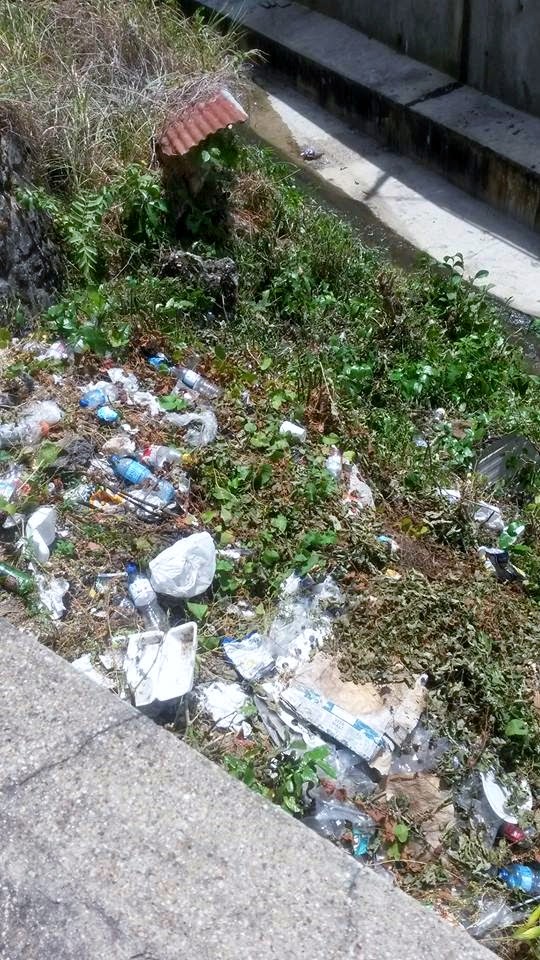“Unfortunately, our
affluent society has also been an effluent society”- Hubert H. Humphrey
The
above picture shows accumulated waste on a grassy river bank, alongside a
street in the city of Port of Spain. It is not an unusual sight to see garbage
piled onto street corners, clogging drains or even gathered beneath a ‘No
Littering’ sign in the city, thereby revealing aspects of pollution. This is no
surprise, we've all seen it; those ‘No dumping of refuse’ signs have become a
joke. According to Drexel University (2002), Pollution is the action of
environmental contamination, of mainly land, water and air, with man-made
waste. Due to industrialization and urbanization, there has been major growth
in the amount of dwellers, users, as well as productive capacity of the city,
thereby increasing the demands for food, shelter and production. As a result, greater
amounts of waste is produced daily and, once disposed of incorrectly, this
waste makes its way onto the city land, waterways, as well as the atmosphere,
thereby tainting its quality and causing degradation of the resource (Conserve-Energy-Future,
2014).
In the
city, side-walks can become polluted by industrial and municipal waste discarded
carelessly by pedestrians and city users. In Port of Spain, in particular, the
lack of adequate waste disposal facilities, such as bins, as well as improper
solid waste management is a major cause of environmental pollution as
individuals are given greater incentive to litter (United Nations Environment
Programme- UNEP, 2001). This, in turn, leads to pollution of city drains and,
inevitably, waterways. As a result, the risk of flooding, that plagues the
city, is intensified and poses a greater threat of infrastructural damage to
city businesses, stores and homes. Therefore, poor waste management continues
to be a great challenge to the well-being of city users as they remain
vulnerable to disasters and health risks.
Air
pollution is another major aspect of urban contamination which occurs mainly as
a result of an increase in gaseous emissions in the atmosphere. Increased
traffic congestion, caused by higher levels of vehicular traffic, largely contributes to atmospheric pollution as greater
quantities of exhaust are emitted over longer periods of commuting. Also, air
pollution can be attributed to poor vehicular maintenance and low fuel quality.
Furthermore, a substantial amount of emissions are emitted from factories,
especially those responsible for energy production, such as PowerGen. According to the United
Nations Environment Programme (2002), urban air pollution costs approximately
2% of the GDP in developed countries and 5% in developing countries, such as T&T. In
addition to this, increasing emissions can affect the entire local population
as it can contribute to health issues, in addition to affecting food security
and climate. The Organisation for Economic Co-operation and Development (OECD)
estimates that by 2050, outdoor air pollution is expected to be the prime cause
of mortality (International Geosphere-Biosphere Programme, 2013). Therefore,
the importance of reducing emissions, as well as pollution on a whole is irrefutable, that is, if we desire to ensure healthy futures, not only for us, but generations to come.
References:
Conserve-Energy-Future. "Causes, Effects and Solutions of Land
Pollution." Last modified 2014.
http://www.conserve-energy-future.com/causes-effects-solutions-of-land-pollution.php.
Drexel University. "Environmental Science - Pollution." Last
modified May 30, 2002. http://www.pages.drexel.edu/~cy34/.
International Geosphere-Biosphere Programme. "Urban air pollution:a
new look at an old problem." Last modified April, 2013.
http://www.igbp.net/news/features/features/urbanairpollutionanewlookatanoldproblem.5.19895cff13e9f675e253f0.html.
United Nations Environment Programme (UNEP). "Environmental
Pollution and Impacts on Public Health." United Nations Environment
Programme (UNEP). Last modified 2001.
http://www.unep.org/urban_environment/pdfs/dandorawastedump-reportsummary.pdf.
United Nations Environment Programme (UNEP). "Urban Air
Pollution." Last modified 2002.
http://www.unep.org/urban_environment/issues/urban_air.asp.

Nice entry. It reminds me that congestion is not just about traffic, but all blockages of flow (drains, sidewalks, as you point out).
ReplyDeleteI tried to cover all the aspects of congestion that exists in the city and tends to be overlooked. Thanks!
Delete